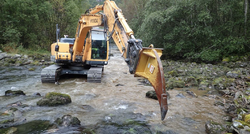Cleaning of substrate - ripping, ploughing and flushing
Contents
Introduction
In rivers with changes in the sediment dynamics and reductions in floods, the substrate will often gradually be clogged and armoured by finer sediments. Floods naturally flush fine materials away, break up the armour layer and re-instate the natural substrate composition. Depending on the time since last flushing and the upstream geomorphological conditions, floods of return period (return periods calculated as before regulation) of maybe 10 years or more might be needed to remobilise the sediment.
Clogging and armouring of the substrate will gradually reduce the interstitial spaces of the substrate, being important shelter for juvenile and small fish. Armouring of the substrate will also make it more difficult for fish spawning within the substrate to dig out their nests and deposit their eggs, and it might also increase the mortality of eggs. This method is not efficient to improve the shelter conditions for adult fish (Pulg et al. 2017).
There are different ways to clean substrate that has undergone gradual clogging and armouring. Ripping a method that makes use of an excavator equipped with a special claw that will mobilise the sediment, and it releases the fine material that is flushed away with the natural flow. Ploughing is a similar method, but it is usually hooked to a tractor that 'ploughs' the river and the fine material is flushed downstream by the natural flow.
Flushing of substrate refers to a method where the substrate is flushed with water under high pressures. This will also lead to the removal of fine sediments from the substrate, if successfully applied. This method is less feasible in rivers where the substrate naturally consists of finer grain sizes. Use of flushing is assumed to get better results when also algae, moss and other vegetation attached to the substrate are supposed to be removed.
It should also be assessed where the fine material that is flushed downstream ends, if it clogs river areas downstream, deposit in a downstream lake or estuary, and what impact that might cause.
Methods, tools, and devices
During planning
A first step in considering cleaning of substrate as a measure to increase the shelter and improve the quality of spawning areas would be to assess if these are limiting factors for the development of fish population, i.e. diagnosis according to the environmental design terminology.
The procedure to assess the quality of the areas suitable for spawning and substrate providing shelter for juveniles could be to follow the prescriptions given in the Environmental Design handbook (Forseth and Harby, 2013). This procedure should be carried out prior to the measure is put in place, and after the measure has been implemented. The Environmental Design handbook suggests a method to assign quantitative numbers, and these numbers can be compared. Research has been carried out to investigate the capabilities of hydraulic models with representation of sediment and erosion processes to simulate the evolvement of substrate characteristics, and it is likely that these models in the future can be used to assess the areas and qualities of spawning areas and shelter, and the effect of measures.
During implementation
Ripping and ploughing will require heavy machinery to be operated within the river. Good access to the river is then a pre-requisite. The excavator to be used for ploughing should be equipped with a claw (a rip) that will move that medium to large sized stoned in order to expose the finer material to the flow that will transport the small size grain away.
If flushing is used to clean the substrate from fine materials, a high-pressure flusher is needed. Flushing is most likely a better approach that ripping and ploughing is moss, algae and other biological material attached to the substrate is to be removed.
It is important that such rough work within the river is carried out when the fish is least vulnerable, avoiding critical periods like spawning season and when eggs hatch and larvae emerge.
This measure will most likely require to be repeated after some years unless the natural sediment conditions and the floods are re-instated.
During operation
Habitat measures to clean the substrate would need to be repeated unless the natural sediment and flow regimes are re-instated, such as flood events and connectivity of the sediments. The frequency of maintenance will hence be very site-specific.
After the measure has been put in place, the improvements in shelter and spawning areas can be measured carrying out the same procedures described for planning.
Classification Table
|
Classification
|
Selection (multiple) |
|
|
Fish species measure designed for |
Atlantic salmon (salmo salar), Trout (salmo trutta) and other gravel spawners |
|
|
Does the measure require loss of power production? |
Structural (requires no additional flow release) |
|
|
Recurrence of maintenance |
Less often than yearly |
|
|
Which life-stage of fish is measure aimed at? |
Spawning and shelter juvenile life-stages |
|
|
Which physical parameter mitigated? |
Substrate |
|
|
Hydropower type the measure is suitable for |
Plant in dam Plant with bypass section |
|
|
Dam height [m] the measure is suitable for |
All
|
|
|
Section in the regulated system measure is designed for |
Bypass section Upstream of hydropower plant Downstream outlet |
|
|
River type implemented
|
Steep gradient (> 0.4 %) Fairly steep with rocks, boulders (< 0.4; > 0.05 %) |
|
|
Level of certainty in effect |
Very certain |
|
|
Technology readiness level |
TRL 9
|
actual system proven in operational environment |

